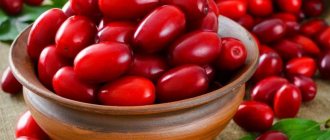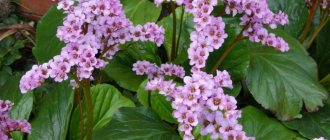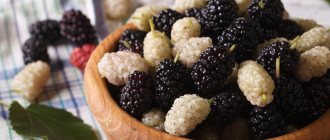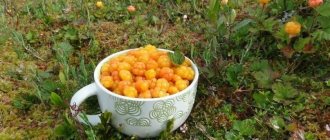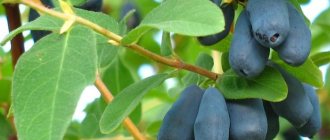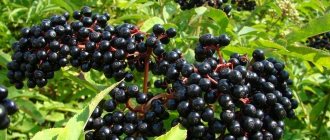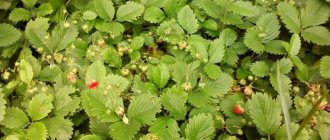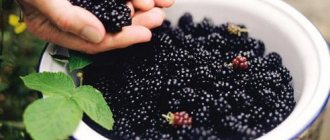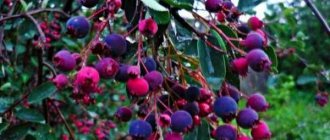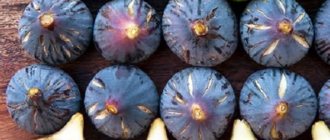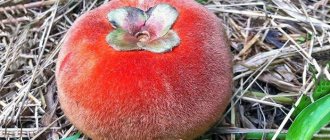Botanical description
The berry looks like a cloudberry. It is represented by herbaceous perennials with erect stems up to 30 cm high. Side shoots spread along leaf or coniferous litter and reach a length of 1.5 m. They are covered with trifoliate leaf plates with slight pubescence. They are attached to the branches using long petioles.
The berry blossoms bloom in late spring and early summer, when small buds collected in corymbose inflorescences bloom. The fruit is formed after successful pollination. Visually, this is a rather large assembled drupe of four smaller berries. The color varies from deep red to orange. The seeds of each fruit are large compared to other berries. It tastes like pomegranate.
Varieties
The most common type of wild berry is the common drupe. You can often hear its other name - “rocky”. Among the indigenous population of the northern regions, the berry is called “stone raspberry”. The fruiting period occurs in the second half of summer. At this time, berries rich in the greatest amount of nutrients are collected.
Knyazhenika is a subspecies of boneweed. The habitats of growth are concentrated in wetlands, as well as wet conifers. The fruits are dark red. A special feature is that the bone can be easily separated from the pulp.
In two more varieties, the differences lie in the botanical structure of the vegetative mass:
- Star drupe - during flowering, large flowers painted in a bright red tone are observed to bloom.
- Hop-leaved - the name of the species speaks for itself. A distinctive characteristic of drupes, which grow mainly in the Far East and Siberia, is wrinkledness. But it affected not only the leaves, but also the seed of the fruit.
Drupes are collected quite rarely, and they do not grow in such quantities as blueberries or lingonberries
How does drupe grow?
It’s not for nothing that drupes are called rocky raspberries - they feel comfortable and grow quickly on rocky areas. This is a herbaceous, perennial plant of the Rubus genus, Rosaceae family. Its closest botanical “relatives” are raspberries, cloudberries and blackberries.
Drupes are almost ubiquitous in Russia. It can be found in the northern regions and in the forests of the middle zone. Except that this berry does not grow in the far south. The plant also grows in the Caucasus, in the countries of Europe and Asia, and in America. Mixed and coniferous forests, steppe meadows are places where stony raspberries grow. She prefers moist soil and moderate light.
Wild drupes can be easily recognized by the following description:
- the plant grows up to 30 – 40 cm in height;
- the stem of the bush is erect;
- creeping shoots, drooping, covered with thorns, spread on the ground, can be up to 150 cm long;
- by autumn the shoots take root, this is one of the ways the plant reproduces, so it grows in breadth, forming a dense carpet;
- Drupe leaves are green, large, trifoliate, and have a rough surface;
- leaves are located on large petioles;
- rhizomes are long, produce root shoots;
- flowering occurs in June, the drupe blooms with small white flowers, often collected in inflorescences of 3–6 pieces;
- Fruit ripening occurs at the end of August - September;
- Drupe fruits are red, edible.
What the drupe looks like depends on the plant variety. There has been no selection of drupes, but wild plants differ somewhat from each other in leaf shape and fruit color. If you want to grow this plant on your site, you can choose the most successful specimen. In addition to stony, other forest varieties are known:
- star drupe - flowers are red, grows mainly in the tundra;
- hop-leaf drupe - the leaf structure resembles hop leaves, they are lumpy, embossed, pubescent, the variety is common in the Far East and Siberia.
Note: in some regions the berry is called a drupe. This erroneous pronunciation is due to the presence of large seeds in the fruits. Because of its creeping shoots, it was popularly called “creeping hop.”
What do stone fruit berries look like and what do they taste like?
Drupe berries look like a group of round red beads; each fruit can consist of 1 – 6 such “balls”. Inside each individual bead berry there is a large seed. The pulp of the berry is juicy and has a sour taste, vaguely reminiscent of pomegranate. Because of this, the stone fruit is sometimes called the northern garnet.
Note: the berries have a pleasant taste, which makes them a valuable culinary product.
The period of ripening of stone fruits occurs at the beginning of autumn. The fact that the berry is ripe is indicated by its bright red color, but some varieties have an orange tint. Collecting the berries is not difficult, as they are easily separated from the base, and each “bead” is removed separately. True, due to the not very abundant fruiting, picking stone fruit berries can be a tedious task.
Note: when picking berries you need to be careful not to damage them. It is better to collect fruits in a basket or glass jar. Bags or cloth bags are not suitable for this, as they will choke the stone fruit berries.
The difference between kostyaniki and princes
You can often hear the opinion that stoneweed and princeweed are the same plant. After looking at photographs of berries and studying their botanical description, it becomes clear that these are completely different representatives of the forest flora, but they are “relatives”.
Also read on our website: Goji berries: is the “superfood” really that good?
The “kinship relationship” is evidenced by the similar features that the princeling and the stone fruit berry have. We have already discussed why the fruit is called this way. So, the presence of seeds in berries is one of the similarities between stone fruit and princeberry . Both berries are red, and the leaves of the bushes are trifoliate, resembling raspberry leaves in appearance. Both plants are used in folk medicine to treat various diseases and improve health. This is where their similarities end. But they have much more differences:
- the stone fruit is easily removed from the stalk, but the knyazhenika is not (when harvesting the knyazhenika, it is recommended to pick the berries along with the base, and sort them out at home, tearing off the stalks);
- in knyazhenika the berries are heavier and the stalks are softer, so the fruits hang down, while in drupes they “look” up;
- Drupes blooms with white flowers, and princely flowers with pink ones;
- in the knuckleberry flowers are collected in inflorescences of several pieces, and in the knyazhenika they are single;
- knyazhenika is a northern berry, and stone fruit is distributed throughout almost the entire territory of our country;
- Drupes are sour, and princesses are sweet, smelling like pineapple.
The picture below clearly illustrates the difference between the fruits. When examining it, it becomes clear that the berries do not have many external similarities.
Habitats
Berry crops can be found in different parts of the world. Drupe specimens are successfully developing both in Central European latitudes, as well as in Asia and America. They can adapt to almost all climatic zones, except for zones with prolonged soil and air drought.
When lingonberries ripen
And although the berry plant, which has medicinal properties, does not like hot weather, it is still found by “hunters” in the forest-steppe and steppe regions.
The most preferred places are in coniferous or mixed forests. You can find drupes near small bushes, as well as in forest clearings and shaded edges. Since the crop prefers high humidity, the search for berries in wetlands will most likely end successfully.
In Russia, the berry grows in all parts of the central zone and north of the state. There is a lot of it in the Ural, Far Eastern districts, and Siberia. The habitat of stone fruit growth in the middle zone is limited to the southern regions. The hot zones of the Krasnodar and Stavropol territories, the Rostov, Volgograd, Astrakhan regions and Kalmykia are not the areas where the berry plant can be found.
Attention! Stoneweed takes root well in the Caucasus Mountains. The microclimate there is favorable for her.
Chemical composition of fruits
Berries contain a high concentration of various vitamins and important chemical compounds. The highest content is vitamin C - about 45 mg. This figure corresponds to half the required daily intake for an adult. The berry also contains other substances:
- bioflavonoids;
- pectin;
- tocopherol;
- phytoncides.
Significant chemical compounds include iron, manganese, zinc and copper. Tannins are also included. Nutritional value with an energy value of 40.5 kcal, per 100 g of product:
| Squirrels | 0.8 g |
| Fats | 0.9 g |
| Carbohydrates | 7.4 g |
The benefits of the harvest of this perennial are invaluable in diets. Recommendations from nutritionists agree that the berries of this shrub should be included in the diet on an ongoing basis. When consumed regularly, bone fruit saturates the body with important chemical compounds and helps strengthen the immune system and improve tone.
Chemical composition and where it grows
Drupe, which grows in northern latitudes and the Caucasus, is not as popular a berry as, for example, its “sister” raspberry. However, in terms of its composition, the northern berry is capable of overtaking many of its competitors.
Not only the drupes themselves, which are rich in high levels of vitamin C, flavonoids, and phytoncides, are unique, but also the leaves of the herbaceous plant.
They contain:
- alkaloids;
- tannins;
- routine;
- zinc and iron;
- tannins.
What's the benefit
Not only berry fruits have beneficial properties. When preparing raw materials, you should not ignore the leaves. They have many medicinal qualities.
Berries
Due to their high content of nutrients, berries are introduced into the diet during periods of autumn and spring vitamin deficiency. Tannins, present there in high concentrations, help suppress pathogens that cause nasopharyngeal diseases.
They demonstrate excellent results in the fight against the following conditions:
- stomatitis;
- pharyngitis;
- primary symptoms of sore throat.
The juice obtained from drupes is an excellent medicine for improving the functioning of the heart muscle. Strengthening blood vessels and restoring their walls are tasks that juice from drupes copes with excellently.
Consuming a healthy “elixir” allows you to cleanse the vascular system of waste and toxins. Reducing cholesterol levels is one of the benefits of wild berry juice.
Drupes make healing drinks from the berries.
With the help of a decoction they cope with diseases of the epidermis of the head. If you apply it daily, you can quickly slow down the development of the disease and improve the structure of the skin.
The decoction demonstrates excellent results in the fight against fungus and psoriasis, and in combination with drug therapy allows for a quick victory over pathogens. Drupes show a positive effect on the hair - it makes them stronger, gives shine and energy.
Leaves
Crushed shoots of the drupe bush have been used in alternative medicine. As a basis for medicinal compositions, they show high efficiency. There are drugs with a general strengthening effect, as well as those that help specifically fight the flu. This is facilitated by the presence of compounds in the leaves that have anti-inflammatory and antipyretic properties.
Cuts and burns are treated with a paste made from the leaves. It is applied to damaged areas of the dermis, where the product destroys bacteria and helps regenerate tissue. Thanks to this mechanism of action, quick application saves injured skin from scarring in the future. The product is effective for inflammation of the joints - it reduces pain.
A decoction of stone fruit leaves is drunk to treat anemia. It increases the concentration of iron in connective tissue.
There is an original folk recipe with which the indigenous people of Siberia use kostyanika for severe fright. For collection, healers use spoiled and spotted leaves as raw materials, and prepare special infusions from them. People believe that taking this infusion helps relieve epileptic seizures.
Drupe leaves are very beneficial for women's health. In case of heavy bleeding during menstrual cycles and in the postpartum period, using a decoction based on crushed shoots can reduce the volume of blood released. The product also relieves pain in the uterine area.
Drupe - the enemy of disease
Drupeberry is not recognized in official medicine, but traditional medicine uses leaves and berries to treat a number of diseases. An infusion of the leaves heals heart pain, headaches, anemia, and scurvy. Anti-inflammatory, antipyretic, and diuretic drugs are made from the berries and leaves. Drupe increases immunity and renews strength after respiratory diseases, strengthens the walls of blood vessels. So it is advisable to keep a jar or two of jam for the winter.
Berry juice can remove toxins, cholesterol, and strengthen blood vessels. It suppresses the reproduction of pathogens of trichomoniasis and balantidiasis.
Epilepsy and fear are treated in an original way in Transbaikalia: they collect stone leaves affected by the fungus (brown spots), dry them and infuse them. Leaves completely covered with brown spots are prized. Obviously, not only the leaves, but also the fungi have medicinal properties. The infusion is taken orally. People consider this method to be effective. But if you decide to be treated this way, our advice to you is to consult a doctor, not a public doctor, but the one who works in the hospital.
Drupe is a berry whose beneficial properties will help against sclerosis, vascular and heart pathologies. This inconspicuous plant is used for many diseases.
Bronchitis
Pour boiling water (1 glass) over the flowers and grass (a tablespoon). Boil for 4 hours and filter. Take 0.25 cups a day several times for a week.
Gastritis
Drink half a glass of berry juice before meals, 4 times a day. Duration of admission – 3 months. To improve metabolism and liver function, prepare an invigorating drink: honey (50 g), stone fruit (500 g), water (1 l). The fruits are poured with cold water, previously boiled. They insist for a day. The water is drained and honey is added. Take a quarter glass 3-4 times a day.
Seborrhea
Pour the roots and leaves (50 g) with water (2 l), boil for 20 minutes over low heat. Leave for 2 hours and strain. Rinse your hair until dandruff disappears (every day).
Anemia
For anemia, it is useful to drink this tea: dried currant leaves, boneberries, and strawberries are mixed in equal quantities. Add a little fir or pine needles. Brew a teaspoon of the mixture in a glass of boiling water. Drink in one go.
Warts
The growths are smeared with fresh berry juice until they disappear completely.
Conjunctivitis
Wash the fresh leaves, mash and place on your eyelids. You can treat eye diseases with a decoction: pour 20 g of dry leaves into a glass of water and boil for a quarter of an hour. Moisten cotton swabs and apply to eyelids.
Women's diseases
A decoction of the leaves helps with postpartum bleeding. It is prepared like this: dry leaves (10 - 12 g) are poured with water (a glass) and boiled for 15 - 17 minutes over low heat. Strain. Take 30 g before meals.
Stroke
Pour 1 - 2 tablespoons of chopped herbs into a glass of boiling water. Let it brew for half an hour. Strain. During the day, drink the entire decoction: a spoonful four times a day after meals (every hour).
Rheumatism
Compresses made from stone fruit leaves are used as a pain reliever for rheumatism.
Haemorrhoids
Sitz baths made from a decoction of boneweed leaves help with hemorrhoids. To prepare, leaves (50 g) are doused with boiling water (3 l), filtered and cooled.
Nuances of raw material procurement
In the first half of summer, the shrub forms an ovary after abundant, successful flowering. Then note filling and gradual ripening. Mass fruiting occurs in the second half of summer. The most intense phase lasts a long time - about 2 months until the end of August or beginning of September.
Depending on the climatic characteristics of the growing regions, the timing of the most active vegetation phases may differ. Also, local weather influences the ripening of fruits - too dry or rainy summers adjust the time of “quiet hunting”.
Drupe berries, when you take the fruit in your palm, are easily separated and remain in your hand
The best time to pick berries is early in the morning, when the sun has already dried the dew on the shoots. The fruits are picked together with the stalk to extend the shelf life of the product by several hours. The containers are small in size with hard walls, maximum 1 liter.
Attention! Since stone fruit berries quickly deteriorate and lose their beauty, the time interval for their processing is limited.
In the Moscow region and Leningrad region
Central Russia is rich in forests, where you can find shrubs with medicinal fruits. Mass fruiting is observed here in the second half of summer. Its end coincides with the end of the summer season.
In the Moscow region and neighboring regions, you should go to the forest, far from highways and railways, to buy bones. This is due to the ability of berries to absorb toxins from the surrounding air. It is better to collect them in the cleanest places possible - on the edges and shaded forest clearings, away from civilization.
Because the Northwest region is cooler and has shorter summers, the fruiting period is slightly different. It comes later and does not last as long. High humidity is a significant advantage. The region is famous for the abundance of berries that grow here in literally every small forest area. And there are a lot of the latter in the Leningrad region.
The most abundant harvests of drupes can be harvested from shrubs in wetlands
In Siberia and the Urals
These areas are characterized by a harsh and changeable climate. Depending on the time of climatic summer, the timing of harvesting varies greatly. With the early melting of snow cover, if in May the mercury column constantly remains between 20 and 25 °C, the period of “quiet hunting” will coincide in time with the middle zone. Prolonged winter cold can delay mass fruiting until the end of summer.
To fill the baskets with nutritious harvest, they go to mixed and coniferous forests. There it is worth carefully inspecting the ravines and edges. And a surprise may await you in the forest clearings. Although the region has a low population density and little production, it is better to refrain from looking for bone mounds near highways and large populated areas.
In one clearing you can see different berries - both stone fruits and lingonberries
Contraindications and possible harm
You should not eat harvest from forest bushes if you are prone to allergies. Individual intolerance is an absolute contraindication. Varicose veins, thrombophlebitis and hypertension are also contraindications for use in excessive quantities.
In addition to avoiding negative effects on the body, you should consult a nutritionist before eating berries. If decoctions are prepared on the basis of stone fruit, you need to visit your doctor, who will make the necessary prescriptions.
Drupe is a common berry plant that produces an abundance of tasty berries. When used correctly, their benefits are invaluable. And most importantly, collecting stone fruits can be combined with active recreation in the soulful company of nature.
Answers on questions
How is stone fruit used in cooking? Jam, compote, juice, kvass, jelly, syrup, jelly, mousse, marmalade, wine, tea, vinegar are prepared from stone fruits. In addition, thanks to its sour taste, it is added to salads and sauces for meat and fish dishes. Drupes are eaten fresh with sugar, cream, and milk.
How to store stone fruit berries? Drupes can be frozen, dried, pickled, soaked, or covered with sugar. Dried berries, if properly collected and prepared, can be stored for several years.
Use of stone fruit berries in cooking
Drupe berries are most often eaten fresh. Once ripe, they become moderately sour and have an interesting taste. They can be eaten with honey, sugar, sour cream, and cream. The fruits are often eaten directly from the bush.
In addition to eating fresh, stone fruit berries are used to prepare various desserts: preserves, jam, jelly, marmalade, compote. Due to the labor-intensive process of picking berries, few people have the strength and patience to collect them for canning. Well, those who are up to this task will definitely not be disappointed: berry jam and other desserts made from stone fruits are surprisingly tasty.
Also read on our website: Red currant: calorie content of fresh, dried, frozen berries
The seeds from the fruits of the stone fruit are also used in cooking. They are dried and ground into powder using a food processor or coffee grinder. This powder is used as a seasoning for preparing main dishes and added to baked goods.
